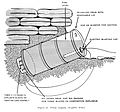Flame fougasse facts for kids
A flame fougasse (pronounced foo-gahss) is a special kind of weapon. It's like a hidden trap or a simple explosive device. It works by using a small explosion to spray burning liquid, like gasoline, onto a target. Imagine a big splash of fire!
This clever weapon was first created in Great Britain during World War II. This was in 1940, when Britain was worried about an invasion. They needed a way to stop enemy tanks. About 50,000 flame fougasse barrels were set up. They were placed in around 7,000 different spots. Most of these were in southern England, with some in Scotland. Luckily, they were never needed in Britain. But this design was later used in battles in Greece.
Contents
What is a Flame Fougasse?
A flame fougasse is a simple but powerful weapon. It's usually made from a metal barrel. This barrel is filled with a flammable liquid. Think of it like a big container of fuel. A small explosive charge is placed behind the barrel. When the charge explodes, it pushes the liquid out. This creates a huge spray of burning fuel.
How Does a Flame Fougasse Work?
The idea is quite simple. First, a metal barrel is buried or hidden. It's often tilted towards where an enemy might come from. The barrel is filled with a mix of fuel. This could be gasoline or other flammable liquids. A small explosive is placed behind the barrel. When the explosive is set off, it creates a sudden blast. This blast pushes the liquid out of the barrel. The liquid then ignites, creating a large fireball. It's designed to cover a wide area with fire.
What Was the Purpose of Flame Fougasses?
During World War II, flame fougasses were mainly used to stop tanks. Tanks are very strong, but they can be damaged by fire. A flame fougasse could create a wall of fire. This would block enemy tanks or even set them on fire. They were also useful because they were cheap and quick to make. This was important when Britain needed many defenses quickly.
Where Were Flame Fougasses Used?
The main use of flame fougasses was in Britain. They were part of the country's defense plan. This was during a time when an invasion by Germany seemed possible.
Flame Fougasses in Britain
Thousands of these devices were set up across Britain. They were often placed along roads or at important crossings. The idea was to surprise any invading forces. They were ready to be used if enemy tanks appeared. Even though they were never fired in Britain, they showed how prepared the country was. They were a sign of Britain's determination to defend itself.
Flame Fougasses in Greece
While not used in Britain, the design proved useful elsewhere. Flame fougasses were later used in Greece. This shows that the basic idea was effective. It was a simple but powerful way to create a fiery defense.
Images for kids






